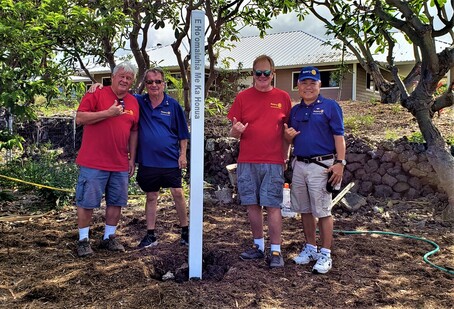 The Rotary Club of Kona Sunrise installed a peace pole at the Innovations Charter School. Photo courtesy of Rotary Club of Kona Sunrise.
The Rotary Club of Kona Sunrise installed a peace pole at the Innovations Charter School. Photo courtesy of Rotary Club of Kona Sunrise. Seeking Peace
The planting of peace poles emerged from the spiritual journey of Japanese philosopher and author, Masahisa Goi. His spiritual path emerged from the dark hours of post-World War II; he realized in the course of his healing work, that people needed help healing their emotional side as well as the physical. To that end, he sought a simple practice that could be done by anyone.
After completing a course of rigorous spiritual training, Masahisa Goi founded Byakko Shinko Kai, an international grassroots organization that transcends cultural, religious, and political boundaries with the vision of promoting world peace through the prayer: “May Peace Prevail Upon Earth,” the first Peace Pole with that message, was planted in 1955 in Hiroshima.
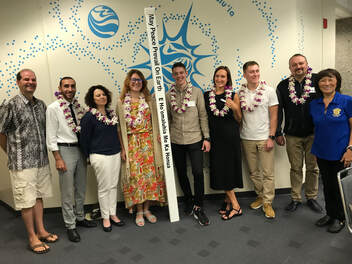 Hilo Rotary Club members hosted an Open World delegation from Russia and together they planted a peace pole in Kuhio Kalaniana'ole Park. Photo courtesy of Charlene Iboshi.
Hilo Rotary Club members hosted an Open World delegation from Russia and together they planted a peace pole in Kuhio Kalaniana'ole Park. Photo courtesy of Charlene Iboshi. On Hawai‘i Island, a committee made up of five East Hawai‘i Rotary Clubs is shining a light on peace through several projects including peace poles. The vision of the Rotary Clubs’ Peace Committee “is not just avoiding conflict, but lifting the community and creating the opportunity for everyone to move forward,” said committee coordinator and Rotary Club of South Hilo member, Charlene Obashi.
Five years ago, the committee, which is made up of members from Rotary Clubs of Hilo, South Hilo, Hilo Bay, Pāhoa, and Volcano, began their initial efforts with addressing homelessness. The first step was to give voice to the needs of the homeless in East Hawai‘i. This led to several projects such as working with Hope Services and other organizations to provide food, paint shelters, and plant food trees. “The idea of peace poles bubbled up out of our Peace Committee,” said Charlene.
Their peace work added an international element when, in the fall of 2019, an Open World (OW) delegation visited Hawai‘i from Russia as part of the Peace Committee’s “Let’s Work it Out” series. Along with visiting energy research labs and sharing knowledge, the OW delegation and Rotary Club members planted a peace pole at Kuhio Kalaniana‘ole Park in Keaukaha.
Since beginning their program, the Peace Committee discovered many peace poles already planted on the island, some in need of refurbishment, and all in need of location and placement on a map, which became an ongoing committee project.
No journey away from home is complete for Bob Juettner, committee member and member of Rotary Club of Hilo Bay, unless he can verify another peace pole or two. Bob has faithfully been placing peace poles on the map with GPS coordinates that the committee hopes to use to create an app. When we spoke, Bob was off to West Hawai‘i on the trail of two new poles installed there; he also shared that a new peace pole was in the works for Kohala.
“We have a dream that people will take a trip around the island and visit the peace poles and make a journey, internally as well as externally,” explained Tim Hansen, special programs director at the Hilo Prosecutor’s Office and Rotary Club of Hilo Bay member.
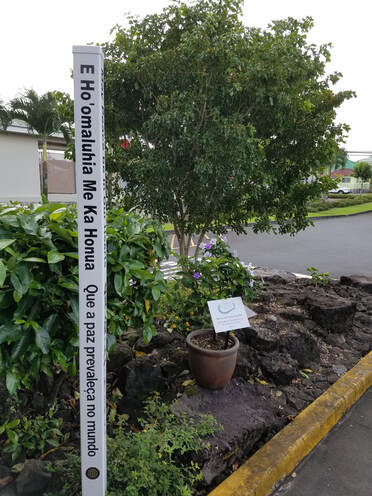 As part of the STARS program developed by the Hilo Prosecutor's Office, a peace garden and peace pole was installed. Photo courtesy of Tim Hansen.
As part of the STARS program developed by the Hilo Prosecutor's Office, a peace garden and peace pole was installed. Photo courtesy of Tim Hansen. Positive ideas, like sparks, can light fires. In 2018, when Al Jubitz, co-founder of the Rotarian Action Group for Peace, came to Hawai‘i Island to share some of the work being done nationally, he sparked island Rotarians into action.
Since that time, West Hawai‘i Rotary Club members have planted peace poles at several locations including Innovations Charter School. “The kids are a good way to start,” said Nestorio Domingo, Rotary Club of Kona Sunrise member and past president. In addition, the club has also planted peace poles at the Old Kona Airport Park, the West Hawai‘i Civic Center, and Pālamanui Community College
Probably one of the oldest peace poles on the island resides at Paleaku Peace Garden. A group from Japan brought a peace pole to the island, seeking a home here. Their journey brought them to the Paleaku Peace Garden in Captain Cook where it was planted overlooking the Kona coast, amongst the many other symbols of peace from a myriad of cultures and faiths.
Peace poles have been planted for many different reasons as a symbol of awareness, a meditational focus for healing, to honor a loved one, or commemorate an event. In Pāhoa, now in the process of recovery from the 2018 volcanic eruptions, a peace pole, sponsored by the Rotary Club of Pāhoa Sunset, was planted at the newly opened Puna Kai Shopping Center and displays the message “May Peace Prevail on Earth” in eight languages.
“The peace pole stands as a reminder to think peace,” said Deborah Nichols, Rotary Club of Pāhoa Sunset president. “The Rotary Club picked Puna Kai Shopping Center because it represents a new beginning for our little town,” she added.
If you have occasion to visit the Prosecutor’s Office in Hilo, in the midst of daily human drama, you will find STARS Peace Garden planted with a peace pole, a memorial to the victims of homicide and their families.
“When we established the garden in Hilo, we knew we wanted a peace pole. We wanted peace to prevail in our community and also in our hearts. The presence of the peace pole in the garden helps people who visit to center and focus. It’s not only to remember our loved ones who were killed, but it’s also for the community and the person who did that harm. It’s an individual journey, a community journey and a world journey,” reflected Tim.
The peace pole at Tutu’s House in Waimea was planted in September 1995, the 50th anniversary of the bombing of Hiroshima. Sophie Oki, then the director, invited Tyrone Rheinhart, who was in Hawai‘i with a delegation of 47 Japanese visitors, to plant a peace pole.
The pole was replanted when Tutu’s House moved to their current location and the recipients of Medtronicʻs “Live On. Give On.” award (sponsored by Earl Bakken) created a garden around it. The following year when the award recipients came, the cap was taken off the top of the Peace Pole and they wrote messages of peace to be sealed inside.
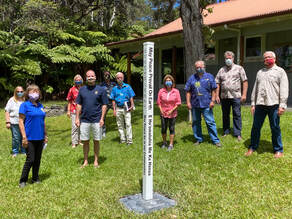 Rotary Club members from Volcano and Hilo gathered to install a peace pole at the Volcano Art Center in Volcano Village. Photo courtesy of Charlene Iboshi.
Rotary Club members from Volcano and Hilo gathered to install a peace pole at the Volcano Art Center in Volcano Village. Photo courtesy of Charlene Iboshi. Paul Field, president of Rotary Club of Volcano was contacted by Charlene about planting a peace pole. “The Volcano Art Center is the hub of the community so we decided to install it there. Mike Nelson and the art center jumped right in. We had a little ceremony with 10 people. We have a plaque under the pole that explains it,” said Paul.
During the ceremony, artist Julie Williams shared her story. “Last year when I went to Hiroshima and saw the peace pole there, I thought it would be so great to have one at the Volcano Art Center [VAC] and then Paul told me that the Rotary Club would like to donate one,” explained Julie.
But the VAC isn’t going to stop there. “This pole has inspired another project at the art center called the Positive Post Project. We are reaching out to six artists and other service clubs to do smaller posts that will have artwork and a positive statement and will be planted along the edge of the forest,” she added.
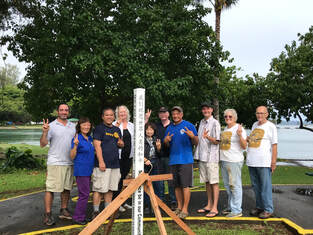 Members of the Hilo Rotary clubs and the Russian delegation installing a peace pole in Kalaniana'ole Park, adjacent to Lili'uokalani Gardens. Photo courtesy of Charlene Iboshi.
Members of the Hilo Rotary clubs and the Russian delegation installing a peace pole in Kalaniana'ole Park, adjacent to Lili'uokalani Gardens. Photo courtesy of Charlene Iboshi. Another peace pole was discovered in Rakuen, an area behind Suisan that is part of Lili‘uokalani Gardens. Landscape architect Kazuo Nakamura developed a waterfall that flowed into a pond that could be viewed from the Nihon Cultural Center, now the Hilo Bay Café.
“At some point between the Nihon Cultural Center and Hilo Bay Café, the peace pole was installed. But the pathway and the pond and the grounds surrounding it have become overgrown and the pole text has been painted over. There's an effort to restore that area around the peace pole as well as the peace pole itself. It’s a real community treasure. You just put the word out that something needs to be done and people show up. The Rotary Clubs came out like gangbusters,” said K.T. Canon-Eger, founder and president of Friends of Lili‘uokalani Garden.
The aloha spirit of Hawai‘i Island has rich resources for peace and so it’s no surprise at the number of peace poles here. Peace begins in the heart of the individual and is about making connections and creating communities that foster beauty and become beacons of peace amidst the chaos of our modern world.
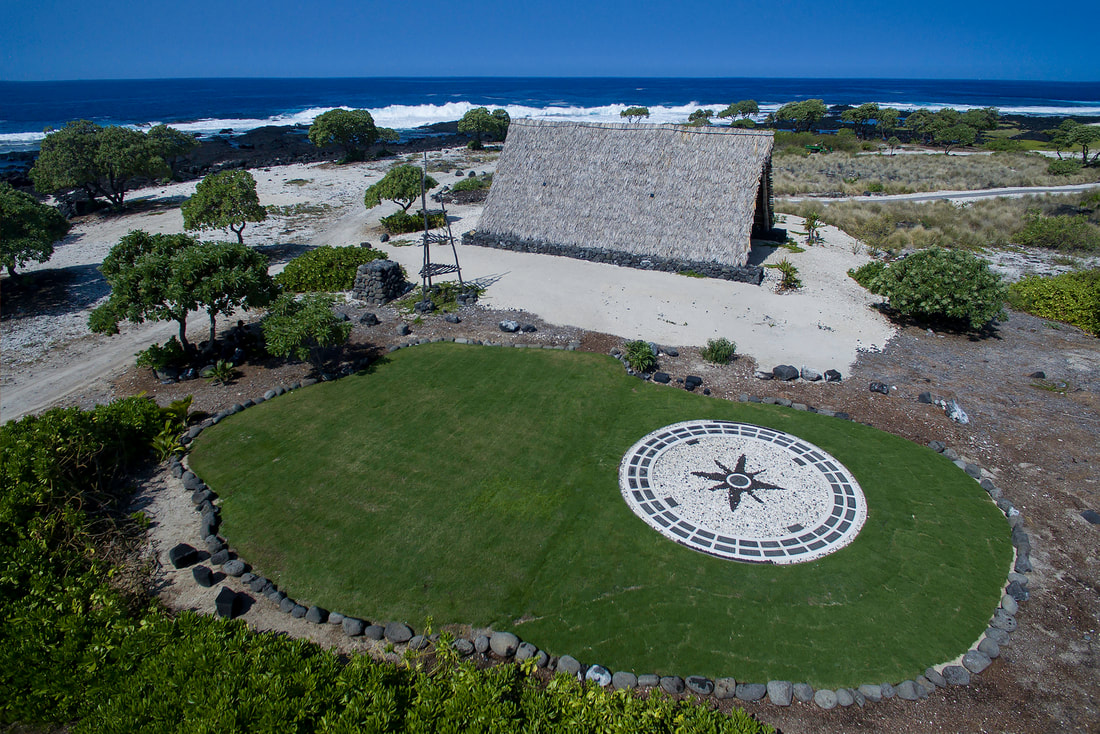
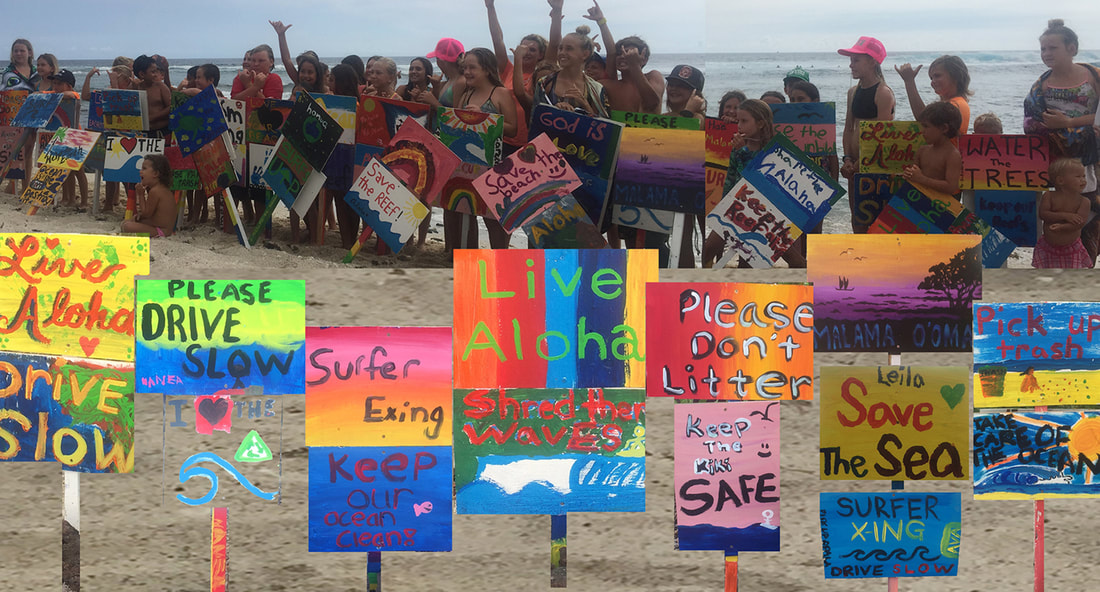
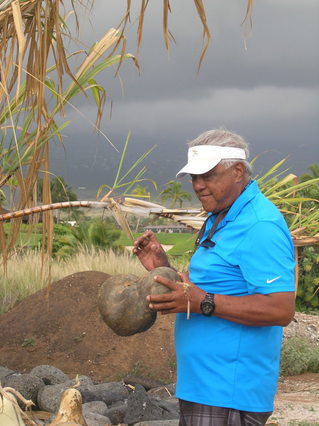
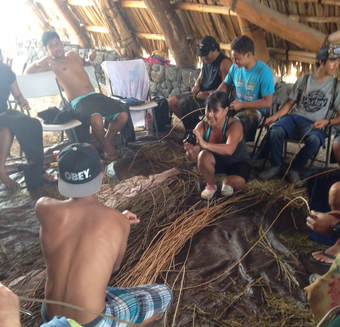
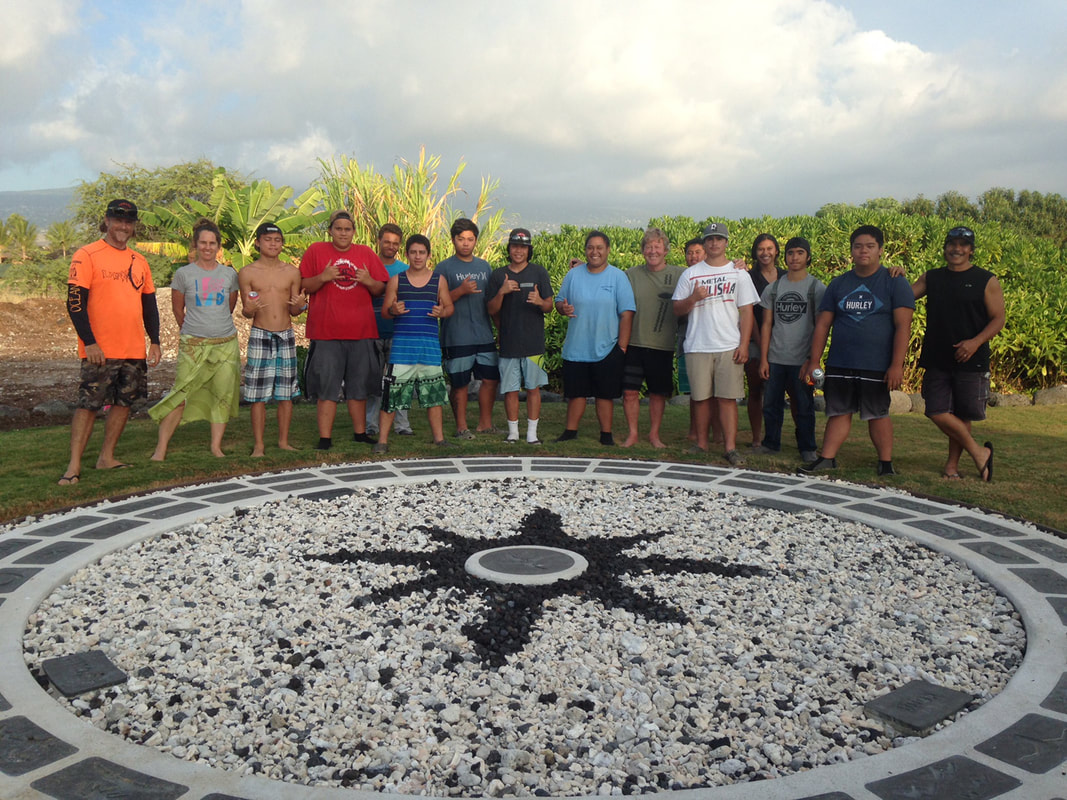
 RSS Feed
RSS Feed
